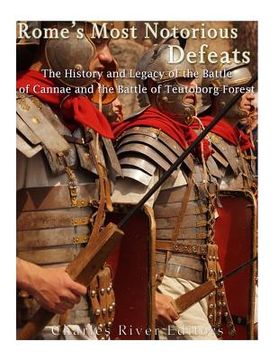Rome's Most Notorious Defeats: The History and Legacy of the Battle of Cannae and the Battle of the Teutoburg Forest (en Inglés)
Reseña del libro "Rome's Most Notorious Defeats: The History and Legacy of the Battle of Cannae and the Battle of the Teutoburg Forest (en Inglés)"
*Includes pictures *Includes ancient accounts of the battles *Includes online resources and a bibliography for further reading Although the Romans gained the upper hand over Carthage in the wake of the First Punic War, the legendary Carthaginian general Hannibal brought the Romans to their knees for over a decade during the Second Punic War. While military historians are still amazed that he was able to maintain his army in Italy near Rome for nearly 15 years, scholars are still puzzled over some of his decisions, including why he never attempted to march on Rome in the first place. Regardless, Hannibal was such a threat that the Romans responded in an unprecedented nature when the Carthaginians resumed the campaigning season in the spring of 216 BCE by capturing the city of Cannae, a crucial supply hub, and placing themselves along the line that convoys from the ports and warehouses of the south needed to travel to reach Rome. This was something the Romans could not and did not take lying down; Rome raised the largest army in their city's history, a force of between 80,000 and 100,000 men, and marched south with Consuls Varro and Paullus at the head of the army. Varro led the Roman legions straight at the center of Hannibal's formation, proceeding in characteristic bull-headed fashion and spearheading the assault himself. Hannibal's troops in the center yielded before the legions, as Hannibal had anticipated, sucking the bulk of the Roman force deep into the centre of Hannibal's formation. Meanwhile, the wings of Hannibal's infantry automatically swung against the flanks of the Roman force. The result was a massacre, one of the most vicious battles in the history of the world. Around 75% of the Roman army was cut down in the ensuing melee, which would be in the vicinity of between 50,000-80,000 soldiers depending on which initial estimates are considered to be accurate. Cannae is still considered one of the greatest tactical victories in the history of warfare, and the fact the battle was a complete victory resulting in the wholesale annihilation of the enemy army made it the textbook example for military commanders to try to duplicate. Of course, others usually were unsuccessful. Cannae was the kind of complete victory that every commander from Caesar to Frederick the Great to Napoleon to Robert E. Lee sought, and that few generals save Caesar and Napoleon bagged whole armies is a testament to the near impossibility of achieving a victory like Cannae. While Rome certainly suffered defeats and outright massacres over the course of its long and storied history, none of them were as disturbing for the Empire as the battle of the Teutoburg Forest in 9 CE. This battle, which took place in Germany, is also known as the Varian disaster, named after the governor of the Roman province, Germania Publius Quinctilius Varus. The battle remains pertinent not only to military historians and archeologists but also to modern military officers around the world as well. As recently as 2009, the United States of America's Army Command and General Staff College published a work that focused upon the Roman legions in the Teutoburg Forest. Indeed, the Battle of the Teutoburg Forest featured some of the finest fighting forces in the world - the Roman legionaries - and a group of people whom the Romans didn't consider human at all - the Germanic tribes. Nonetheless, the battle between these two forces, in the narrow confines of the Teutoburg Forest, would be a turning point in the histories of both nations. Never again would Rome seek to establish a colony and create a functioning province out of the Germanic area; in fact, the Romans never ventured east of the Rhine River after the disastrous expedition.

